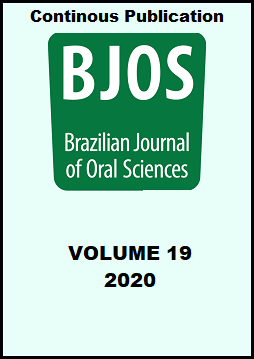Abstract
Aim: To determine total fluoride (TF) concentration in Na2FPO3/Ca-based toothpastes, using fluoride ion selective electrode (F-ISE) by the direct technique, it is necessary to use acid (Ac+) to hydrolyze the FPO3 2- ion and to dissolve insoluble fluoride salts bound to the abrasive. For NaF/silicabased toothpastes, the use of acid is not necessary (Ac-) and a simplified protocol could be followed. Methods: Thus, we evaluated TF concentration in seven brands of NaF/silicabased toothpastes, following the validated conventional Cury’s protocol (Ac+) or a simplification of this protocol (Ac-). Fluoride was analyzed with ISE calibrated with fluoride standard solutions prepared in the same conditions as the samples (Ac+ or Ac-). Results: The mean (±SD; n=21) of TF concentrations (μg F/g) found by Ac+ (971.3±191.2) and Ac- (982.4±201.3) protocols were not statistically different (t test, p=0.22). The TF concentrations found agree with those declared by the manufacturers, except for one toothpaste imported from China. Conclusion: The findings suggest that the determination of fluoride in NaF/silica-based toothpastes can be accurately made using a simplified protocol of analysis.
References
Martinez-Mier EA, Tenuta LMA, Carey CM, Cury JA, van Loveren C, Ekstrand KR, et al. European Organization for Caries Research Workshop: Methodology for Determination of Potentially Available Fluoride in Toothpastes. Caries Res. 2019;53(2):119-36. doi: 10.1159/000490196.
Pearce EIF. A laboratory evaluation of New Zealand fluoride toothpastes. N Z Dent J. 1974 Apr;70(320):98-108.
Cury JA, Guimarães LOC, Arbex ST, Moreira BW. [Analysis of fluoride dentifrices: concentration and chemical formula of the fluorides encountered in Brazilian products]. Rev Assoc Paul Cir Dent. 1981 Mar-Apr;35(2):142-7. Portuguese.
Tenuta LMA, Cury JA. Laboratory and human studies to estimate anticaries efficacy of fluoride toothpastes. Monogr Oral Sci. 2013;23:108-24. doi: 10.1159/000350479.
Cury J, Oliveira M, Martins C, Tenuta L, Paiva S. Available fluoride in toothpastes used by Brazilian children. Braz Dent J. 2010;21(5):396-400. doi: 10.1590/s0103-64402010000500003.
Marin LM, Vieira Filho W, Tenuta LMA, Tabchoury CPM, Cury JA. [Reproducibility and validity of fluoride dentermination in toothpastes with ion specific electrode by direct analysis]. Braz Oral Res 2016;30(Suppl 1):68. Abstract AO0090. Portuguese.
Sarmiento RV, Issao M, Cury JA. [Study of the availability and stability of fluoride in dentifrices sold in Peru]. Rev Stomatol Hered 1994(1-2):12-20. Spanish.
Conde NC, Rebelo MA, Cury JA. Evaluation of the fluoride stability of dentifrices sold in Manaus, AM, Brazil. Pesq Odontol Bras. 2003;17(3):247-53. doi: 10.1590/s1517-74912003000300009.
Hashizume LN, Lima YB, Kawaguchi Y, Cury J. Fluoride availability and stability of Japanese dentifrices. J Oral Sci. 2003 Dec;45(4):193-9. doi: 10.2334/josnusd.45.193.
Cury JA, Tabchoury CPM, Piovano S. [Fluoride concentration and stability in dentifrices sold in the Autonomous City of Buenos Aires]. Bol Ass Argent Odontol Ninos. 2006;35:4-8. Spanish.
Cury JA, Tenuta LM, Ribeiro CC, Paes Leme AF. The importance of fluoride dentifrices to the current dental caries prevalence in Brazil. Braz Dent J 2004;15(3):167-74. doi: 10.1590/s0103-64402004000300001.
Carrera CA, Giacaman RA, Muñoz-Sandoval C, Cury JA. Total and soluble fluoride content in commercial dentifrices in Chile. Acta Odontol Scand 2012 Dec;70(6):583-8. doi: 10.3109/00016357.2011.640287.
Ricomini Filho AP, Tenuta LM, Fernandes FS, Calvo AF, Kusano SC, Cury JA. Fluoride concentration in the top-selling Brazilian toothpastes purchased at different regions. Braz Dent J. 2012;23(1):45-8. doi: 10.1590/s0103-64402012000100008.
Giacaman RA, Carrera CA, Muñoz-Sandoval C, Fernandez C, Cury JA. Fluoride content in toothpastes commercialized for children in Chile and discussion on professional recommendations of use. Int J Paediatr Dent 2013 Mar;23(2):77-83. doi: 10.1111/j.1365-263X.2012.01226.x.
Cury JA, Vieira-Dantas ED, Tenuta LMA, Romão DA, Tabchoury CPM, Nóbrega DF, et al. [Fluoride concentration in the most sold MFP/CaCO3-based Brazilian toothpastes at the expiration time]. Rev Assc Paul Cir Dent. 2015;69:248-51. Portuguese.
Fernández CE, Carrera CA, Muñoz-Sandoval C, Cury JA, Giacaman RA. Stability of chemically available fluoride in Chilean toothpastes. Int J Paediatr Dent. 2017 Nov;27(6):496-505. doi: 10.1111/ipd.12288.
Marín LM, Vieira W, Tenuta LMA, Tabchoury, CPM, Cury JA. [Available fluoride concentration in local dentifrices from Brazilian regions]. Rev Assoc Paul Cir Dent. 2017;71(1):60-5. Portuguese.
Soysa NS, Cury JA, Alles CNRA. Fluoride concentration and stability in commonly used dentifrices in Sri Lanka. Braz J Oral Sci. 2018;17:e181244. doi: 10.20396/bjos.v17i0.8654067.
Chávez BA, Vergel GB, Cáceres CP, Perazzo MF, Vieira-Andrade RG, Cury JA. Fluoride content in children's dentifrices marketed in Lima, Peru. Braz Oral Res. 2019 Jul 1;33:e051. doi: 10.1590/1807-3107bor-2019.vol33.0051.
Marin LM, Castiblanco GA, Usuga-Vacca M, Cury JA, Martignon S. Fluoride chemically soluble in toothpastes sold in Colombia. CES Odontologia 2020. Forthcoming.
Coelho CSS, Cury JA, Tabchoury CPM. Chemically Soluble Fluoride in Na2FPO3/CaCO3-Based Toothpaste as an Indicator of Fluoride Bioavailability in Saliva during and after Toothbrushing. Caries Res. 2020;54(2):185-93. doi: 10.1159/000506439.

This work is licensed under a Creative Commons Attribution 4.0 International License.
Copyright (c) 2020 Brazilian Journal of Oral Sciences


